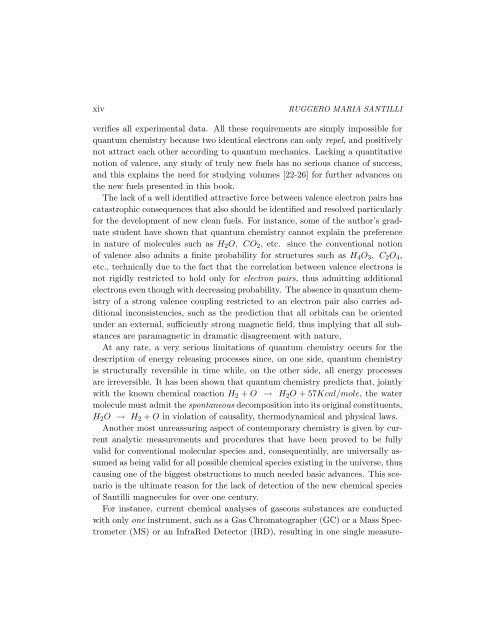the new fuels with magnecular structure - Institute for Basic Research
the new fuels with magnecular structure - Institute for Basic Research
the new fuels with magnecular structure - Institute for Basic Research
Create successful ePaper yourself
Turn your PDF publications into a flip-book with our unique Google optimized e-Paper software.
xiv<br />
RUGGERO MARIA SANTILLI<br />
verifies all experimental data. All <strong>the</strong>se requirements are simply impossible <strong>for</strong><br />
quantum chemistry because two identical electrons can only repel, and positively<br />
not attract each o<strong>the</strong>r according to quantum mechanics. Lacking a quantitative<br />
notion of valence, any study of truly <strong>new</strong> <strong>fuels</strong> has no serious chance of success,<br />
and this explains <strong>the</strong> need <strong>for</strong> studying volumes [22-26] <strong>for</strong> fur<strong>the</strong>r advances on<br />
<strong>the</strong> <strong>new</strong> <strong>fuels</strong> presented in this book.<br />
The lack of a well identified attractive <strong>for</strong>ce between valence electron pairs has<br />
catastrophic consequences that also should be identified and resolved particularly<br />
<strong>for</strong> <strong>the</strong> development of <strong>new</strong> clean <strong>fuels</strong>. For instance, some of <strong>the</strong> author’s graduate<br />
student have shown that quantum chemistry cannot explain <strong>the</strong> preference<br />
in nature of molecules such as H 2 O, CO 2 , etc. since <strong>the</strong> conventional notion<br />
of valence also admits a finite probability <strong>for</strong> <strong>structure</strong>s such as H 4 O 3 , C 2 O 4 ,<br />
etc., technically due to <strong>the</strong> fact that <strong>the</strong> correlation between valence electrons is<br />
not rigidly restricted to hold only <strong>for</strong> electron pairs, thus admitting additional<br />
electrons even though <strong>with</strong> decreasing probability. The absence in quantum chemistry<br />
of a strong valence coupling restricted to an electron pair also carries additional<br />
inconsistencies, such as <strong>the</strong> prediction that all orbitals can be oriented<br />
under an external, sufficiently strong magnetic field, thus implying that all substances<br />
are paramagnetic in dramatic disagreement <strong>with</strong> nature,<br />
At any rate, a very serious limitations of quantum chemistry occurs <strong>for</strong> <strong>the</strong><br />
description of energy releasing processes since, on one side, quantum chemistry<br />
is structurally reversible in time while, on <strong>the</strong> o<strong>the</strong>r side, all energy processes<br />
are irreversible. It has been shown that quantum chemistry predicts that, jointly<br />
<strong>with</strong> <strong>the</strong> known chemical reaction H 2 + O → H 2 O + 57Kcal/mole, <strong>the</strong> water<br />
molecule must admit <strong>the</strong> spontaneous decomposition into its original constituents,<br />
H 2 O → H 2 + O in violation of causality, <strong>the</strong>rmodynamical and physical laws.<br />
Ano<strong>the</strong>r most unreassuring aspect of contemporary chemistry is given by current<br />
analytic measurements and procedures that have been proved to be fully<br />
valid <strong>for</strong> conventional molecular species and, consequentially, are universally assumed<br />
as being valid <strong>for</strong> all possible chemical species existing in <strong>the</strong> universe, thus<br />
causing one of <strong>the</strong> biggest obstructions to much needed basic advances. This scenario<br />
is <strong>the</strong> ultimate reason <strong>for</strong> <strong>the</strong> lack of detection of <strong>the</strong> <strong>new</strong> chemical species<br />
of Santilli magnecules <strong>for</strong> over one century.<br />
For instance, current chemical analyses of gaseous substances are conducted<br />
<strong>with</strong> only one instrument, such as a Gas Chromatographer (GC) or a Mass Spectrometer<br />
(MS) or an InfraRed Detector (IRD), resulting in one single measure-














